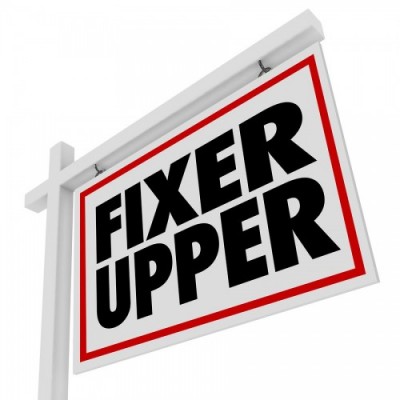Fixer Upper – Fix & Flip – The Next Stage of Real Estate Investing
Fixer upper houses can save you a ton of money when invested in properly – these homes can go for as little as 60 percent to 80 percent of the original asking price. But failing to do the proper research can leave you in a financial fix and more work than you’re ready for.
So how do you decide if you’re ready to invest in a fixer upper house? As far as the task of rehabbing or remodeling, you can go one of two routes. If you want to do the improvements yourself, ask yourself what improvements you’re capable of, or at least willing to put a fair amount of work in. If you watch a lot of home improvement shows, you know how much work can go into a home; but these shows can make it all look like child’s play and leave you ill-prepared for what you might encounter. Stripping wallpaper and painting are some of the easiest tasks you can do, but tasks involving electrical or plumbing can not only be difficult but dangerous when done haphazardly. Make sure you’re ready to commit to what may come out to months of work, depending on how much time you can invest.
If you prefer hiring a contractor to do the work, you either know someone who you can trust in construction or you have to be very careful in hiring a reliable person or company. Word of mouth is the best way to find reliable help, but still you have to test the contractor yourself and see if you can trust him and keep costs within budget.
Want to learn about the 4 possible outcomes in real estate investing (fix and flip is just one of them)?
Check out this Webinar, where I will go into detail about different strategies that you can apply today,
including investing in fixer uppers.
Fixer Upper:
Fixer upper homes usually fall into two categories: ugly houses and total wrecks – ugly houses may look unappealing and not worth your time, but their repairs are often minor; bad smells, bad paint jobs, bad yard. These fixes are cheap and more likely than not you can do them yourself with little outside help. Ugly houses are also considered the ideal fixer upper homes, because they cost much less than what they return in market value.
It’s the total wrecks that can drain your funds quickly; and in fact are recommended by real estate experts to avoid altogether. This is because these kinds of repairs are usually ‘invisible’ and hardly ever raise the value of the house enough to offset their costs.
While doing a walkthrough make sure to pay special attention to things like the foundation, roofing, and siding as these are usually the most expensive areas to repair and are also the most likely to slip by unnoticed in your initial walkthrough. Try to know as much about your fixer upper as possible before putting in your offer – coming across unexpected problems such as a cracked foundation or hidden mold can only cause headaches and frustration.
If the sellers seem a little wary about the price, it might be a good idea to share the repair estimates with them, to prove it’s a fair offer.
Of course it’s important to make sure you have enough available funds for the down payment, closing costs, and repairs for your fixer upper. It may be smart to look into the FHA’s Section 203(k) program – a program designed to help those who are purchasing or refinancing a home that needs renovation by combining the purchase and renovation costs into a single mortgage. In order to qualify for this loan, the total value of the property must fall within the FHA mortgage limit for your area. Another option is the streamlined 203(k) program which provides an additional amount for rehabilitation on top of an existing mortgage, and can often be a simpler process than obtaining the standard option.
A lot of investors choose the route of using hard money or private money. There are several lenders nowadays who are “asset based lenders,” meaning that they are willing to loan based on the after repair value of the property, not necessarily the borrower’s credentials (credit and financials.)
Want to learn about the 4 possible outcomes in real estate investing (fix and flip is just one of them)?
Want to know what works in real estate investing today and why?
Check out this Webinar, where I will go into detail about different strategies that you can apply today, including investing in fixer uppers.
 Subscribe to our podcast
Subscribe to our podcast 

